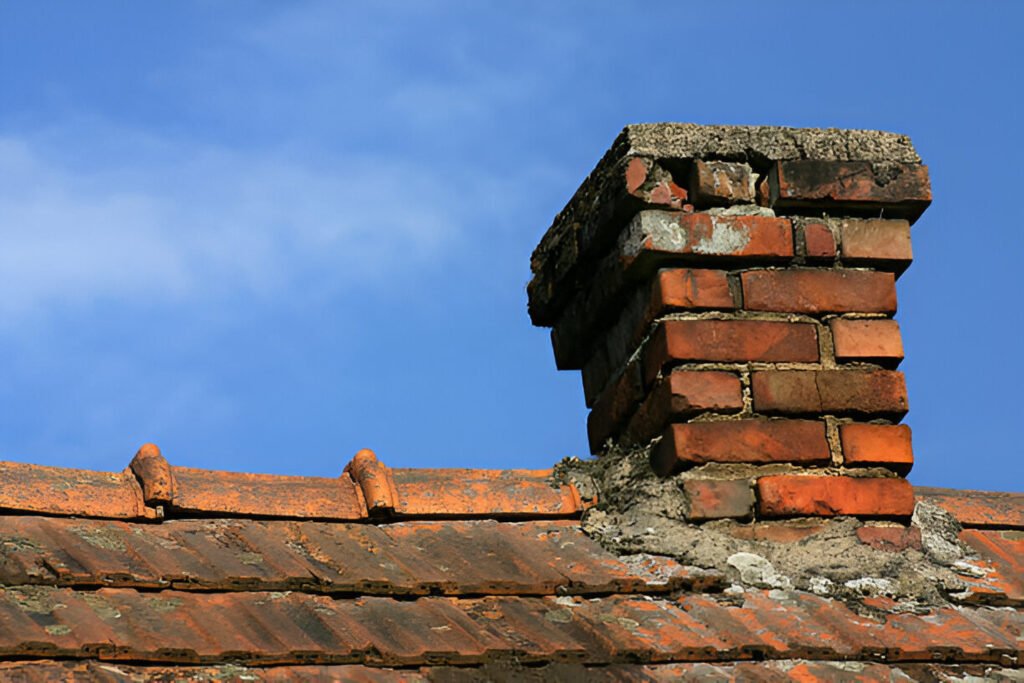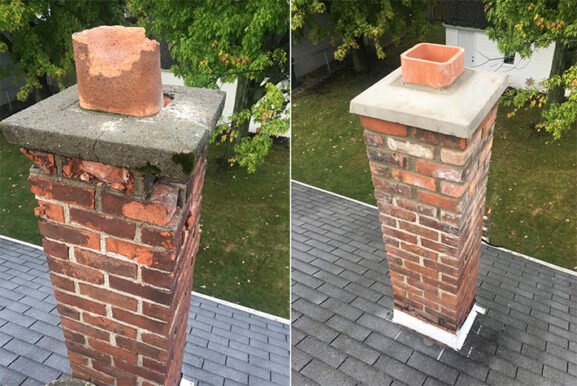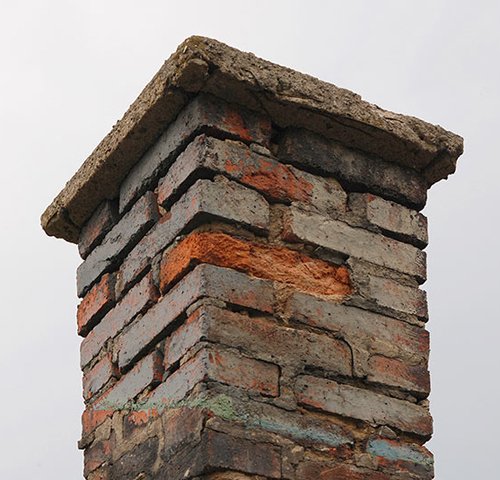Comprehensive Masonry Repair for Cracked Chimneys: Signs, Methods, and Prevention Tips

Key Takeaways
- Cracked chimneys pose serious safety and efficiency risks, including structural damage and fire hazards, if left unaddressed.
- Common causes of chimney cracks include weather exposure, foundation settlement, and poor installation practices.
- Signs of chimney damage, such as visible cracks, interior water stains, or shifting structures, require prompt professional inspection and repair to prevent further issues.
- Essential masonry repair methods include tuckpointing, crack injection systems, and crown sealing to restore stability and protect against future damage.
- Routine chimney inspections and preventive maintenance, like waterproofing and seasonal care, can help avoid costly repairs and extend your chimney’s lifespan.
- Consulting professional services ensures proper repairs, compliance with safety standards, and long-term chimney durability.
A cracked chimney isn’t just an eyesore—it’s a potential hazard that can compromise your home’s safety and efficiency. Over time, weather exposure and general wear can cause masonry to deteriorate, leading to structural issues and even fire risks. Ignoring these cracks can turn a small problem into a costly repair down the line.
Common Types of Chimney Cracks and Their Causes
Understanding the types of chimney cracks and their causes helps in identifying chimney cracks early and addressing them promptly to prevent further structural issues.
Weather-Related Damage
Exposure to weather elements often leads to the most common forms of chimney damage. Freeze-thaw cycles can cause cracks by expanding water trapped in the masonry. Seasonal maintenance for masonry chimneys protects against these cycles and minimizes harm.
Signs of weather damage include spalling bricks, crumbling mortar joints, and minor cracks. Solutions like applying waterproof coatings or sealing minor cracks with masonry sealant prevent water infiltration. Professional chimney inspection ensures early identification of issues before they worsen.
Foundation Settlement Issues
Chimneys built on unstable foundations tend to develop vertical or diagonal cracks as the base shifts. These structural issues may compromise the chimney’s stability and lead to significant risks.
Reinforcing the chimney structure with solutions like steel bars can reduce instability from settlement. For larger cracks, repointing mortar joints or replacing crumbling bricks might be necessary. Consulting expert masonry services prevents improper fixes while ensuring long-term safety.
Poor Installation Problems
Improper installation methods, like using low-quality materials or incorrect construction techniques, often result in premature cracking. Weak mortar joints and misaligned bricks are typical outcomes.
Addressing these issues begins with choosing quality masonry materials and ensuring proper chimney flashing. Masonry repair for cracked chimneys includes repointing or using fire-resistant mortar. For severe damage, chimney rebuilding may be required to maintain integrity and prevent water infiltration.
External resources like the National Fire Protection Association provide guidelines on maintaining chimney safety and stability.
Signs Your Chimney Needs Professional Repair
Recognizing when your chimney requires repair can save time, money, and prevent dangerous issues from escalating. Here are key signs that it’s time to call for professional help.
Visible External Cracks
Cracks in the exterior masonry can appear as hairline fractures or wide gaps. Small cracks might seem harmless but can worsen with weather exposure. Addressing spalling bricks, repointing mortar joints, and sealing minor cracks with masonry sealant are effective solutions before damage spreads. Replacing crumbling bricks is often necessary if damage progresses beyond superficial cracks.
If left untreated, minor external cracks can lead to severe structural problems. Reinforcing the chimney structure using steel bars or choosing quality masonry materials helps maintain stability. A professional chimney inspection ensures the cracks are properly assessed and repaired, preventing further structural issues and improving chimney aesthetics.
Interior Water Damage
Staining or damp walls near the fireplace often indicate water infiltration. Damaged flashing, cracked mortar joints, or gaps in the chimney crown are common culprits. Seasonal maintenance for masonry chimneys, such as applying waterproof coatings and ensuring proper chimney flashing, can protect against future water damage.
We recommend professional assistance for repairing chimney crown defects and sealing chimney joints to stop water leaks. Ignoring water damage risks further harm to the masonry and potentially costly chimney rebuilding for severe damage. A National Fire Protection Association (NFPA) guide NFPA resource offers tips on protecting against freeze-thaw cycles and preventing water-related issues.
Shifting or Leaning Structure
A chimney leaning away from the house or visibly shifting signals significant instability—this might be caused by foundation settlement or eroded mortar. Shifts also increase the risk of flue liner damage, which compromises your home’s safety.
Professional masonry repair for cracked chimneys often involves reinforcing the chimney with steel bars, repointing mortar joints, or patching small cracks to stabilize the structure. In extreme cases, chimney rebuilding may be necessary to restore stability and prevent further structural problems. Professional chimney inspections can accurately identify these issues and provide a tailored repair plan.
Recognizing the signs early ensures the safety of your home and chimney while reducing repair costs.
Essential Masonry Repair Methods
Masonry repair for cracked chimneys ensures safety, enhances longevity, and improves aesthetics. Various methods address different chimney damage types, from minor cracks to significant structural concerns.
Tuckpointing and Repointing
Tuckpointing for damaged mortar restores stability by replacing worn mortar between bricks. Mortar joints weaken due to freeze-thaw cycles, water infiltration, and aging. Repointing involves removing deteriorated mortar and filling gaps with a durable, fire-resistant mortar to reinforce chimney structure.
Issues arise when mortar erosion leads to gaps, exposing bricks to moisture and potential spalling. Addressing spalling bricks reduces further structural issues. A professional chimney inspection evaluates mortar strength and determines the need for repointing.
Crack Injection Systems
Crack injection systems seal minor cracks with masonry sealant, preventing water infiltration. This technique involves injecting repair solutions into cracks, ensuring long-term protection against moisture-related damage. Proper application reduces risks of seasonal freeze-thaw cycles worsening the damage.
If ignored, patched small cracks can deepen, requiring costly chimney rebuilding for severe damage. Using concrete repair solutions enhances chimney stability and prevents water intrusion.
Crown Repair and Sealing
Repairing chimney crowns protects against rain, snow, and debris. Damaged crowns allow water infiltration, leading to issues like crumbled mortar joints or internal water damage. Applying waterproof coatings seals cracks and shields the surface.
Crown sealing, when done promptly, ensures proper chimney flashing and prevents erosion. For extensive crown deterioration, replacing sections with quality masonry materials guarantees durability. Strengthening the crown supports chimney aesthetics and stability.
For more information on chimney safety and repair methods, consult the National Fire Protection Association.
Preventive Maintenance Tips
Preventing chimney cracks and damage ensures both safety and cost savings in the long term. Following these tips can help maintain the structure and functionality of your chimney.
Regular Inspections
Scheduling regular inspections helps identify early signs of chimney damage, including cracks, spalling bricks, and crumbling mortar. Signs such as uneven mortar joints and minor cracks require immediate attention to prevent further structural issues.
- Professional Chimney Inspection: Annual checks by certified professionals can uncover hidden problems like flue liner damage or missing flashing. For safety guidelines, refer to the National Fire Protection Association’s standards.
- Seasonal Maintenance for Masonry Chimneys: Extreme frost or heat changes can cause freeze-thaw cycles, which weaken masonry materials. Inspections before winter or after storm-heavy seasons protect against these effects.
Skipping inspections might lead to chimney rebuilding for severe damage, which costs significantly more than preventive watchfulness.
Waterproofing Solutions
Waterproofing prevents water infiltration, one of the leading causes of chimney damage. Proper water protection extends the life of the masonry.
- Applying Waterproof Coatings: A professional can apply breathable, high-quality coatings that prevent moisture from seeping into bricks and mortar. It’s excellent for addressing spalling bricks caused by water exposure.
- Sealing Chimney Joints: Using masonry sealant for patching small cracks keeps water out, avoiding internal damage such as mold or weakening of the chimney crown.
- Ensuring Proper Chimney Flashing: Faulty flashing is a gateway for leaks. Waterproof flashing not only protects the roofline but also preserves other areas prone to water intrusion.
Ignoring waterproofing solutions can lead to reinforcing the chimney structure later if it sustains water damage over time.
Hiring a Professional Chimney Repair Service
When it comes to chimney repairs, trusting a professional ensures the job is done right the first time. Cracked chimneys pose serious risks, and addressing them promptly with expert help can save us from costlier problems down the road.
By working with skilled masonry specialists, we can restore the safety, functionality, and appearance of our chimneys. Regular inspections and maintenance are key to catching issues early and protecting our homes from long-term damage.
Let’s prioritize our chimney’s health by seeking professional services and following recommended preventive measures. A safe and sturdy chimney is an investment in our home’s safety and longevity.
Frequently Asked Questions
What are the dangers of a cracked chimney?
A cracked chimney can lead to serious safety risks, including increased fire hazards, structural instability, and water damage to your home. Ignoring cracks can cause further deterioration, resulting in costly repairs or even a complete chimney rebuild.
What causes chimneys to crack?
A cracked chimney can lead to serious safety risks, including increased fire hazards, structural instability, and water damage to your home. Ignoring cracks can cause further deterioration, resulting in costly repairs or even a complete chimney rebuild.
How can I identify signs of chimney damage?
Common signs include visible cracks on the chimney exterior, crumbling mortar, leaning structures, spalling bricks, and interior water damage. These indicators suggest the need for immediate professional inspection and repair.
How can I prevent my chimney from cracking?
Regular professional inspections, seasonal maintenance, and applying waterproof coatings can help prevent chimney cracks. Addressing small cracks early and protecting the chimney from weather-related damage are crucial measures.
What types of chimney repairs are available for cracks?
Professional repairs include tuckpointing or repointing to restore mortar, crack injection systems for sealing small cracks, and crown sealing to prevent water damage. Reinforcement methods may be used for structural issues caused by foundation settlement.
When should I call a professional to inspect my chimney?
You should call a professional if you notice visible cracks, water leaks, crumbling mortar, or structural shifting. Annual inspections are also recommended to uncover hidden damage and ensure the chimney’s safety.
Why is waterproofing important for chimney maintenance?
Waterproofing protects against moisture infiltration, which is a leading cause of chimney damage. Applying breathable waterproof coatings and sealing chimney joints can significantly extend the chimney’s lifespan.
Can small chimney cracks be ignored?
No, even small cracks can worsen over time, allowing moisture to seep in and lead to larger structural issues. Prompt repairs can prevent costly complications and ensure home safety.
How often should I have my chimney inspected?
It’s recommended to have your chimney professionally inspected at least once a year. Regular inspections help identify early signs of damage and prevent significant repairs later.
Where can I find resources on chimney safety?
The National Fire Protection Association (NFPA) is a reliable resource for chimney safety guidelines and maintenance tips. Consulting their standards can help homeowners stay informed about proper care and repairs.

